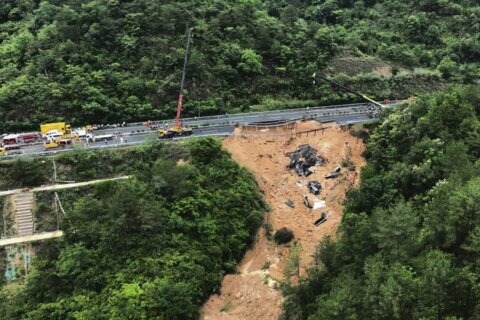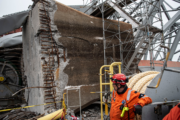SALAR, Afghanistan (AP) — Mina Ahmed, 45, smears a cement mixture to strengthen the walls of her war-ravaged home in rural Afghanistan. Her hands, worn by the labor, are bandaged with plastic scraps and elastic bands, but no matter, she welcomes the new era of peace under the Taliban.
She was once apprehensive of the group’s severe style of rule in her native village of Salar, where they have long held sway. But being caught in the cross-hairs of a two-decade long war has granted her a new perspective. Taliban rules come with limits, even for women, and that is alright, she says.
But she draws the line on one point: Her daughters, ages 13, 12 and 6 must go to school.
From a bird’s eye view, the village of Salar is camouflaged against a towering mountain range in Wardak province. The community of several thousand, nearly 70 miles from the capital Kabul, serves as a microcosm of the latest chapter in Afghanistan’s history — the second round of rule by the Taliban — showing what has changed and what hasn’t since their first time in power, in the late 1990s.
As Salar residents embrace the new stability, they fear a worsening economic crisis. But changes are afoot, beginning with the villagers’ insistence on keeping an elementary school for girls open.
The small school, funded by international donors, has the reluctant support of the Taliban, but only time will tell what the school will become: A formal public school paving the way to higher education, a religious madrasa, or something in between.
By 8 a.m., 38 small faces framed by veils are seated on a carpeted floor looking up at Qari Wali Khan, a madrasa teacher by training. He calls on them to recite from the Quran.
In three hours, the students, ages 9-12 will cover Quranic memorization, mathematics, handwriting, and more Islamic study.
The school opened just two months ago, marking the first time in 20 years girls in the village have ever stepped foot in a classroom, or something like it. In the absence of a building, lessons are held in Wali Khan’s living room.
The classes are the product of U.N. negotiations with the Taliban.
In 2020, the U.N. began working on a program to set up girls’ learning centers in conservative and remote areas, including ones under Taliban control at the time, like Sayedabad district where Salar is located.
Taliban interlocutors were initially reluctant to embrace the idea, but an agreement was eventually reached in November 2020, said Jeanette Vogelaar, UNICEF’s chief of education. International funding was secured, $35 million a year for three years to finance 10,000 such centers.
Launch was delayed by COVID-19. By the time centers were scheduled to open, the Taliban had taken over in Kabul. To everyone’s surprise, they allowed to project to go ahead, even committing to use the previous government’s curriculum — though they have introduced more Islamic learning and insisted on gender segregation and female teachers.
Wali Khan, a madrasa teacher by training, got the job in Wardak because most educated women had left for the capital.
The program enables girls without formal schooling to complete six grades in three years. When completed, they should be ready to enter Grade 7.
The question of whether they can continue after that remains unresolved. In most districts, the Taliban have prohibited girls ages 12-17 from going to public school.
Still, it’s a good start, Vogelaar said. “Based on what we see now, somehow the Taliban doesn’t seem to be the same as how they behaved before,” she said.
Ten years ago, the Taliban were at the forefront of a deadly campaign targeting government officials in Wardak, with particular venom reserved for those campaigning for girls’ schools. Two village elders recounted the shooting death of Mirajuddin Ahmed, Sayedabad’s director of education and a vocal supporter for girl’s access to education.
Several public girls’ schools were burned down in 2007 in the province. To this day, not a single one stands.
Times have changed.
“If they don’t allow girls to go to this school now, there will be an uprising,” said village elder Abdul Hadi Khan.
There are concerns within the United Nations of what kind of schooling might go on behind closed doors, and if donors would condone them if it came to light. The U.N. is aware the Taliban enter villages and insist on more Islamic study, said Vogelaar.
After class, Sima, 12 runs home leaving a cloud of dust in her wake.
Her father, Nisar, is away picking tomatoes in the fields for 200 afghanis ($2.5) a day. He is their only breadwinner.
Her mother Mina is still mixing cement.
Mina expects it will be a long time before her home is in one piece again.
She’s rebuilding bit by bit, buying cement bags for the equivalent of $1 whenever she can. She has accumulated some 100,000 afghanis ($1,100) in debt to relatives and friends.
The family, who fled to a safer part of the village 11 years ago during the fighting, returned home just a month ago. Only one of the house’s four rooms was usable. Walls are still riddled with bullet holes.
Mina fears what will happen as temperatures drop and market prices rise in Afghanistan’s economic crisis.
Food shortages are taking a toll. The Mohammed Khan Hospital, the only one in the district, is struggling with a rising number of malnourished newborns wailing in the maternity ward. Drought has decimated the harvest, wrecking livelihoods.
When October ends, so does tomato-picking season, and Nisar will be out of work.
He joins his wife in mixing cement.
He points to the room once occupied by Afghan soldiers, and then Taliban insurgents after them.
“My daughter will become a teacher one day, and we will make this into a school for her to educate other girls.”
“She will be our pride,” he said.
Copyright © 2024 The Associated Press. All rights reserved. This material may not be published, broadcast, written or redistributed.







